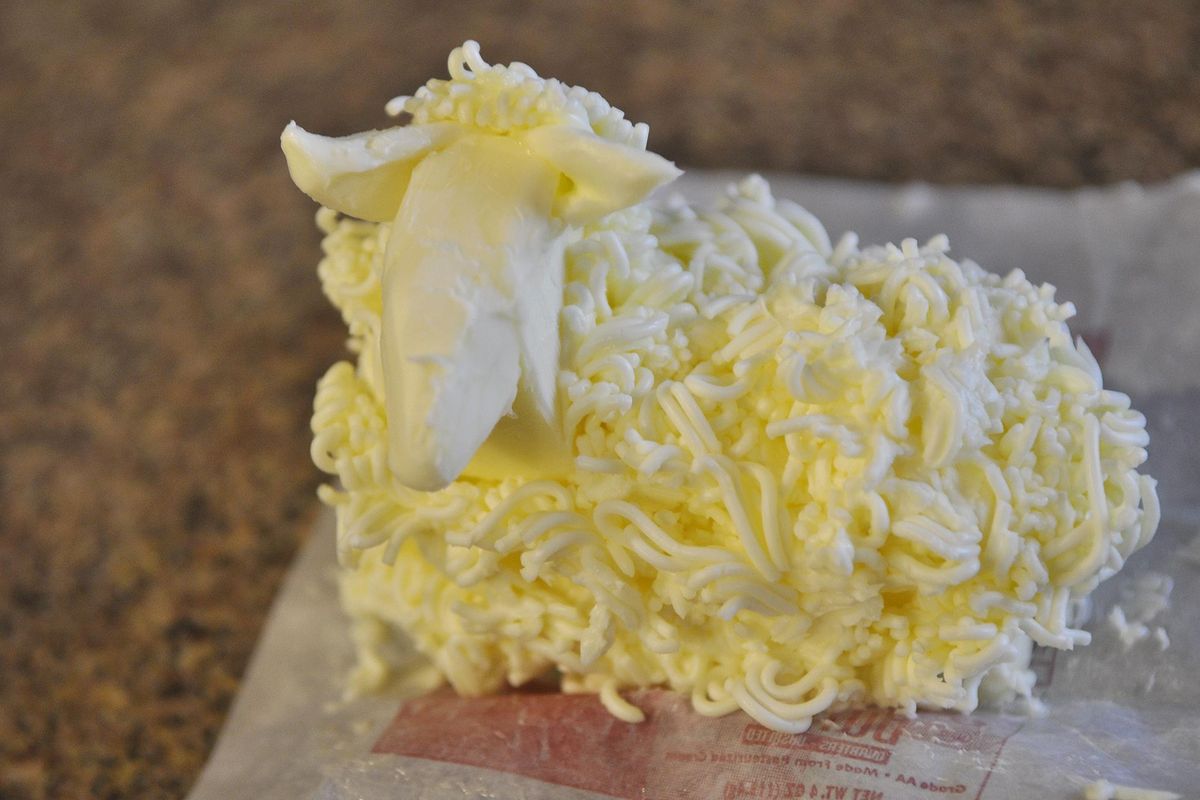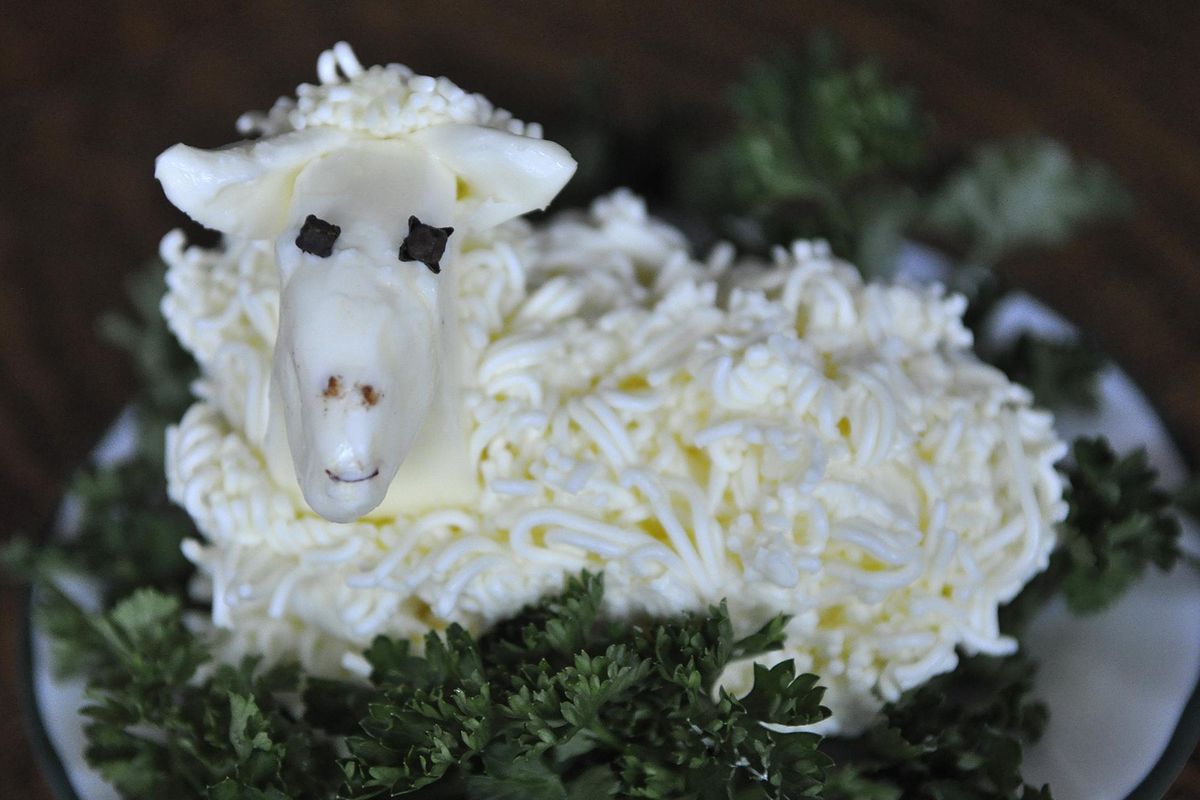Make a Polish butter lamb for Easter
Butter lambs, like this one, sculpted from two sticks of butter, are a Polish tradition at Easter. (Adriana Janovich / The Spokesman-Review)Buy a print of this photo
It usually looked more like a cheerful lion than a little lamb.
But I always thought it was cute, if not a little funny-looking. I don’t remember a butter lamb on the table every Easter growing up. But it was something I got a kick out of as a kid, a way to honor our Polish heritage and help decorate the table – along with tulips and daffodils and hand-painted wooden eggs, or pisanki.
Butter lambs are an Easter tradition in Poland, particularly among Catholics. The lamb is a symbol of spring and new life. It’s also a symbol of Jesus, referred to in the Bible as “the lamb of God.”
In the old country, the butter lamb would be tucked into an Easter basket – along with sausage, cheese, salt, horseradish, babka, bacon, eggs, a candle, greenery, ribbons and linen – and be brought to church to be blessed by a priest. Some parishes in the U.S. continue the tradition.
We never took our butter lamb to church. But we did take Easter baskets to the Polish Home Association, located on Seattle’s Capitol Hill.
At Easter, some specialty Eastern European markets in the States sell machine-molded butter lambs, especially in cities where there are large communities of Polish Americans. But I never remember seeing any in stores growing up in Seattle. Our butter lamb was always shaped by hand.
That’s how it was done traditionally, too – pushing butter through a sieve to make the fur. Mom used a garlic press. A potato ricer would work, too.
Still others used old-fashioned wooden molds, filling the hollows with softened butter, then chilling them until they set up.
Mom sculpted ours from two sticks of butter, using one as the base and cutting the other in half to serve as the neck and head. She usually didn’t do much in terms of shaping snout. Hence, the likeness to a merry little lion.
I had never made a butter lamb myself – until this year. Perhaps I was feeling nostalgic for those Easters of the 1980s when Grandpa hid the Palmer chocolate bunnies and Grandma made Polish pastry – rogaliki, babka, makownik.
There might have been round or two of “Sto Lat,” a traditional song – almost like a toast – that wishes someone long life. And the adults might have turned to Polish when they didn’t want the children to know what they were talking about. At least, that’s what it seemed like to me at the time.
Maybe they just slipped back into their mother tongue when they were happy and comfortable, and we were all together. Or, maybe, it was a bit of both.
Regardless, Mom, who emigrated when she was a toddler, always answered in English. So, sometimes we’d get the gist.
Easter lunch is usually held at her house now. She buys the chocolate bunnies these days, but doesn’t hide them. Grandpa died 15 years ago, and Grandma hasn’t baked in years. She turns 88 in May.
Both were on my mind as I watched a trio of YouTube videos for butter lamb-making tips, including how to shape the snout and ears. The women in the videos used a ricer to make the wool, but I couldn’t find mine. So, like Mom, I used a garlic press, creating more of a shaggy mane than closely sheared coat.
I used cloves for eyes, but peppercorns would work, too. Dots of cinnamon doubled as nostrils. A saffron thread made for an upturned mouth.
As a girl, there was something both exciting and a little sad about cutting away pats of butter from the Easter butter lamb. There was an instinct to shear slivers from the base, preserving the happy face for as long as possible. That’s apparently still my strategy.
The centerpiece, of course, is meant to be eaten. It’s a fatted lamb, full of calories as well as symbolism, a rich reward after the abstention of indulgences during Lent. Still, I’ve found myself trimming little tastes for toast from the hindquarters and sides, trying to save the saffron smile, prolonging the inevitable.
Polish Easter Butter Lamb
2 sticks ( 1/2 pound) cold butter
1 tablespoon butter, softened
1/8 teaspoon ground cinnamon
2 whole cloves or peppercorns
Fresh parsley sprigs, for garnish
Edible flowers, for garnish (optional)
Place one stick of butter on a serving dish to make the base of lamb’s body. Cut the other stick in half, and place it on the left side of the base. Use a knife to trim the top piece, shaping it into the lamb’s neck and head, and reserving the excess butter.
Shape a rectangle from the excess butter or remaining half stick to form the lamb’s snout and secure it to the head piece. Use the tip of a knife to form two smaller rectangles to form the lamb’s ears. Secure the base of the rectangles to the back of the head, making sure the ears are pointing away.
Working in batch, place remaining butter into a garlic press or potato ricer. Squeeze butter through the utensil. Use toothpicks or skewers to help remove and curl pieces. Starting at the top and working down, apply the wool to the lamb’s body.
If the butter softens too much during assembly, refrigerate it for about 10 minutes or until firm.
Insert cloves or peppercorns for eyes. Use the skewer or toothpicks to dot cinnamon on for a nose. A saffron thread can be used for the mouth. So could another smidgeon of cinnamon. To serve, arrange parsley and edible flowers around the butter lamb.



